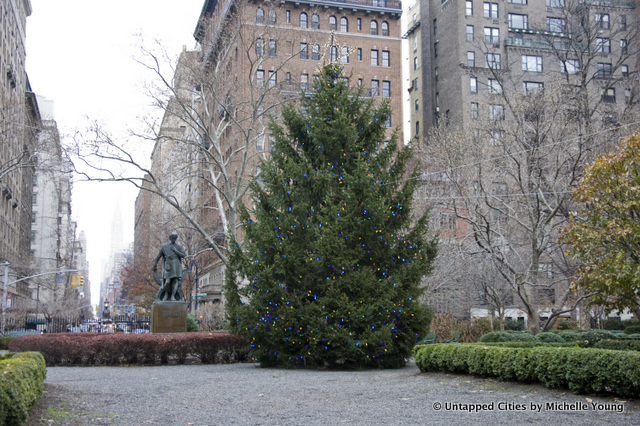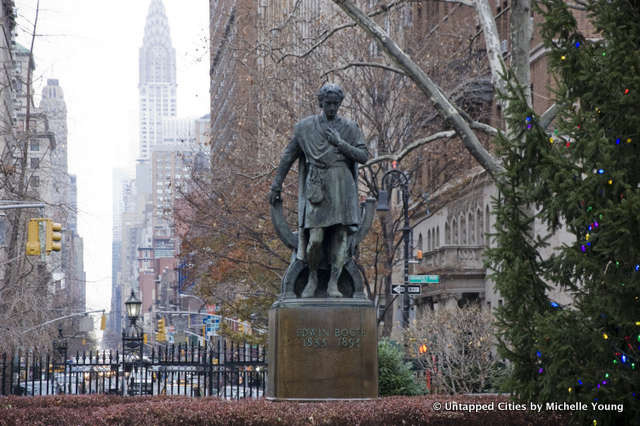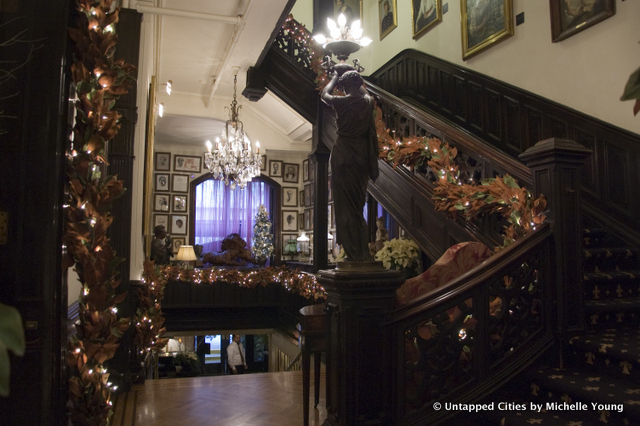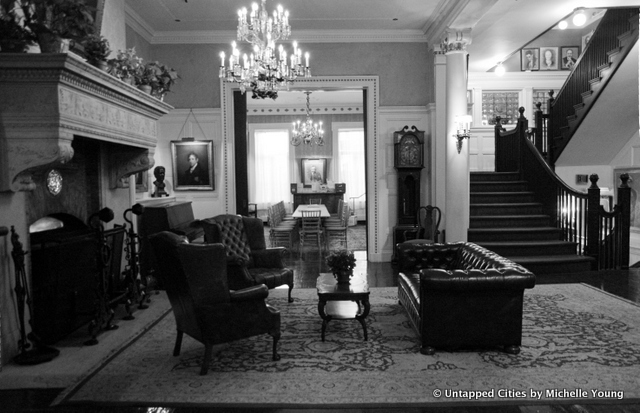 Christmas tree inside Gramercy Park
Christmas tree inside Gramercy Park
On December 17, 1831 a deed by Samuel Ruggles established the plot of land between 3rd Avenue and Park Avenue South from 18th to 21st Streets as Gramercy Park. Today one of the priciest and most exclusive parts of the city, this historic district features tree-shaded streets and 19th century residences that stem from 1840s brownstones to Victorian and neo-Geothics. Ruggles drained the swamp that was previously there, planting all types of trees. Still, it was hard to convince people to live this far uptown but Ruggles had a vision and continued to plant.
 Edwin Booth statue in Gramercy Park
Edwin Booth statue in Gramercy Park
The deed of 1831 added privileges to the park only for its surrounding residents. These hold true today–Gramercy Park is completely closed by lock and key, accessible to tenants of the Gramercy district. Ruggles is also responsible for laying out Irving Place, named for his friend Washington Irving, and the portion of Lexington Avenue that runs south to north. According to Essortment, Ruggles did this “in the face of the prevailing wisdom that a maritime city’s main thoroughfares should run east and west between the rivers. Sam knew the city would grow north and the people would come. When they did come, the residents received golden keys with which to unlock the gate to the park.”
Here are some quirky facts and notables about Gramercy Park, also from Essortment:
Gramercy Park West – No. 4, the home of James Harper, has two mounted iron lamps, following the custom of New York mayors to announce their domiciles to the public. James Harper was the founder of Harper Brothers publishers, later Harper & Row.
 The National Arts Club
The National Arts Club
Gramercy Park South (East 20th Street) – No. 15 was the home of Samuel Tilden, Governor of New York. The windows have original sliding steel panels and the house has a secret passageway to 19th Street, through which Tilden might avoid political enemies and escape New York City’s roving riots. It is now the Gilded Age National Arts Club.
 The Players Club
The Players Club
Gramercy Park South No. 16, the Players’ Club, was the home of Edwardian actor Edwin Booth, brother of Abraham Lincoln’s assassin John Wilkes Booth. The club has a portrait of Edwin Booth by John Singer Sargent hanging over the main fireplace. There is a bronze statue of Booth in his role as Hamlet inside the park. No. 16 is a truly exquisite brownstone with a two story Tuscan porch and iron lanterns. No. 19 was the Hamilton Fish house in the 1890s, later occupied by publicist Ben Sonnenberg, and actor John Barrymore. It has undergone a recent restoration. No. 23, now the Brotherhood Synagogue, was the Friends Meeting House, a lovely building, austere enough for Quakers, built in 1859 and set in a patio type yard.
Gramercy Park North (East 21st Street) Dominated by the current Gramercy Park Hotel on what was the site of the Stanford White home. The house had been occupied more by White’s wife than by Stanford White, who had a bachelor apartment on top of the old Madison Square Garden. He was shot to death in the Roof Garden there on June 25, 1906 by the husband of his lover, Evelyn Nesbit, a Floradora Girl.
East 19th Street (Between Irving Place and Third Avenue) Known as “The Block Beautiful” – this is a row of mainly stuccoed buildings that were remodeled early in the 20th century by Frederick J. Sterner. The block was an informal colony for artists and writers in the 1920s and 1930s, such as author Ida Tarbell, painter Cecilia Beaux, and the sculptor Zolnay. Music critic and novelist Carl Van Vechten, lived at 151 East 19th Street and with his neighbors, painters George Bellows and Robert Chanler, threw wild parties, about which Ethyl Barrymore commented, “I went there in the evening a young girl and came away in the morning an old woman.”
Read more about our Untapped adventures in this exclusive part of Manhattan here. Get in touch with the author @uptownvoice.





